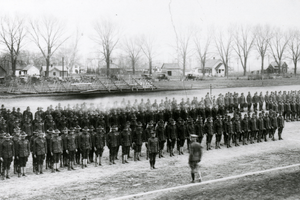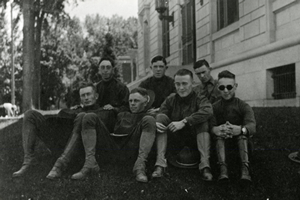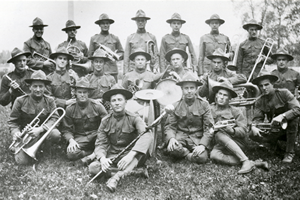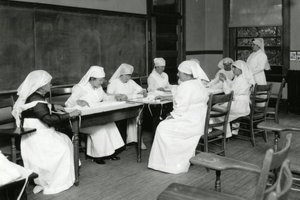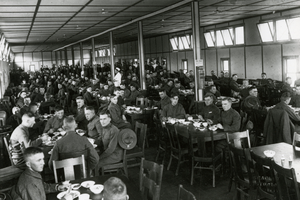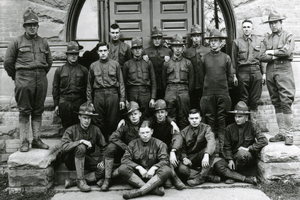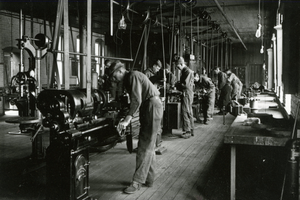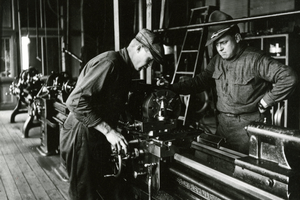
World War I and Fort Collins
Pictured above are military cadets on the campus of Colorado Agricultural College, present-day Colorado State University, circa 1917-1918.
The United States Enters the War
In April of 1917, the United States entered into the Great War that had been raging in Europe for three years. From a strength of under 200,000 men and officers at the declaration of war, the US armed forces mushroomed twenty-fold to 4 million men by the end of the war, 2 million of whom were in Europe. Regular Army troops, National Guardsmen, enlistees, and draftees made up this enormous force. Officers and noncoms to lead these green soldiers were almost as untrained as the men they commanded. Great shortages of equipment ensued, with artillery pieces among the items in short supply. It was not unusual for soldiers to go through training and transportation to Europe before they actually received weapons.
Although confident of the abilities of American soldiers, the generals were almost as lacking in experience as the men in ranks. John J. Pershing was selected to lead the American Expeditionary Force (AEF). Pershing in 1916 had led a punitive expedition into Mexico in pursuit of Pancho Villa. Although Villa escaped, and Pershing's force numbered only about 10,000 men, the campaign did give Pershing and his subordinates some knowledge of new technologies such as aircraft and motorized vehicles. Nevertheless, neither Pershing nor other American generals knew anything of the Western Front and conditions of warfare there. The American commanders believed that marksmanship with rifles and the use of bayonets would result in successful advances. British, French, and German generals had learned through catastrophic battles that artillery barrages, poison gas, machine guns and snipers prevailed over individual rifleman. Their soldiers relied upon knives, hand grenades and trench mortars on those occasions when they were engaged in close-in fighting. Part of the American experience on the Western Front would be to learn these lessons in costly battles. The need to surmount training, organizational, and transport difficulties meant that large numbers of Americans would not arrive in Europe until the spring and summer of 1918.
Local Connections: Fort Collins and Battery A
Battery A, originally a National Guard unit, was formed at Colorado Agricultural College (present-day Colorado State University) in 1915 and became part of the 148th Field Artillery Regiment of the U.S. Army during the war. The personnel in the battery were students, faculty, and alumni of the college. During four months in combat the battery took part in three major battles and one on a smaller scale. The smaller battle has no formal name, but the participants referred to it as "Death Valley." The three major battles were the Second Battle of the Marne (also known as the Aisne-Marne Offensive), the Battle of St. Mihiel, and the Battle of the Meuse-Argonne. The Meuse-Argonne remains the largest battle ever fought in American history, with 1.2 million American troops involved and a casualty roll of approximately 122,000 dead and wounded. Battery A therefore had a significant role in a major world event.
The Archive at Fort Collins Museum of Discovery houses a scrapbook that captures one soldier's experience of the war in Battery A, Mr. John Hurdle. The first date that appears in Hurdle's scrapbook is from July of 1917. The scrapbook is filled with photographs and handwritten notes that track Battery A's route through the fields of war and includes many images of Fort Collins citizens.
Armistice
On November 11, 1918, an armistice with Germany was signed in a railroad carriage at Compiègne. The ceasefire went into effect at 11am, and for the soldiers of Battery A, the war was effectively over.
"There was none of the cheering or the excitement, crying, weeping, hugging and slapping of shoulders that you would want to see. It is hard to express our feelings. We were tired." Fort Collins Weekly Courier, December 27, 1918
One hundred years later, the changes wrought on the world as a result of World War I - the Great War - are still being studied, discussed, and debated.
"No one can say precisely why it happened... which may be, in the end, the best explanation for why it did. The causes of the war are as complex as the world it set aflame. To recall them is to enter a world of great and growing contrasts - visible signs of complex forces that seem destined to collide. It is a world on the edge of great change." --National WWI Museum and Memorial
